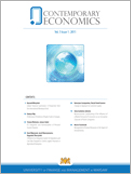Growth Dynamics of Value-Added Tax Revenue in Ghana
Growth Dynamics of Value-Added Tax Revenue in Ghana
Author(s): Francis Kwaw Andoh, Nehemiah E. Osoro, Eliab LuvandaSubject(s): Economic development, Financial Markets, Public Finances, Fiscal Politics / Budgeting
Published by: Akademia Ekonomiczno-Humanistyczna w Warszawie
Keywords: value-added tax; consumption tax; tax collection and fiscal policy;
Summary/Abstract: The introduction of the value-added tax (VAT) to replace the sales tax in 1995 was one of the key policy steps undertaken by the government of Ghana (GoG) to further deepen and sustain the efficiency of Ghana’s tax system to boost tax revenue. This study uses quarterly data from 2000 to 2014 and employs dynamic ordinary least squares (DOLS) and Divisia Index approaches to examine the growth of Ghana’s VAT revenues and how this growth is affected by discretionary tax measures. On the whole, the study finds that all of the measures of VAT revenue (total VAT, domestic VAT, and import VAT) have experienced some growth. Growth in total VAT and import VAT is driven strongly by growth in the base, while that of the domestic VAT is driven by both discretionary tax measures and the tax base. Discretionary tax measures are found to have a depressive effect on both total VAT and import VAT revenue growth.
Journal: Contemporary Economics
- Issue Year: 13/2019
- Issue No: 2
- Page Range: 147-174
- Page Count: 28
- Language: English

